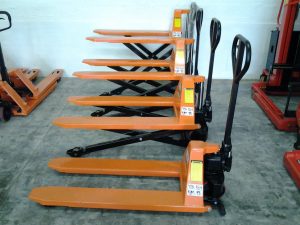Pallet Trolley
Pallet trolleys are mechanical tools used to haul and manoeuvre items of fr eight. They are best suited for short distances and usually only elevate a load high enough for unobstructed travel. They are often used in conjunction with a pallet or skid, but many types of loads can be supported by the jack’s forks.
eight. They are best suited for short distances and usually only elevate a load high enough for unobstructed travel. They are often used in conjunction with a pallet or skid, but many types of loads can be supported by the jack’s forks.
Operation
As the name implies, pallet trolleys are frequently relied upon to transport pallets of materials. Pallets trolleys are used to provide a structural foundation and common footprint of various materials requiring transport; items on the pallet are usually secured via shrink wrap or bundling. This containerization makes shipping and handling more efficient across many industries. Pallet Trolleys do not replace the elevation or hauling capabilities of a forklift, but often supplement a forklift in warehouse situations as they are nimbler and manually-powered models do not require recharging/refuelling. They are often used in retail stores because of their relatively low hazard risk.
Size and Capacity
Pallet Trolleys almost always have fork widths of 7″ or 9″, but the measurement between the furthest edges of the forks can range between 20–47″. The load-bearing span is known as the carriage. Models with a width above this range are used in specialty applications and some models come with an adjustable carriage width. The length of the forks is imperative to a pallet trolley’s ability to safety transport loads. Lengths often range from 32″ to 90″ depending upon the intended application.
The dimensions of the load-carrying components rarely determine the capacities of pallet trolleys, which come in ranges of 1,000 to 15,000 lb. Higher-capacity pallet trolleys are more likely to have additional components, such as a hand brake, reflectors, or motorized locomotion, to safely transport heavy burdens.
Lift
Elevation is always a product of a hydraulic or pneumatic input. Manual versions require the operator to pump the handle to supply fluid to the high-pressure piston; a purge valve lowers the forks back to the ground. Motorized versions will incorporate a hydraulic pump to supply lift. Stroke is the measurement of elevation that a pallet trolley can provide and while most versions will have strokes of just several inches, some are capable of strokes calculable in feet.
Freight Handling
While the pallet’s intention is to ship materials in a widespread footprint to ease handling requirements, most parts of the world do not conform to a single pallet design. A pallet trolley should accommodate the pallet size that is most utilized in the market and industry in which it serves. Recall that the pallet’s overall dimensions are less significant than the span between fork entrances. It may also be important to consider the pallet’s type and material. Few pallet trolleys will incorporate an adjustable fork to better fulfil inter-market functionality.
Mobility
Pallet trolleys rely on four wheels to transport materials and are polyurethane, nylon, or rubber in composition. Smaller wheels recess into the jack’s forks for loading (called load wheels) and unloading while larger, swivelling, tandem wheels are positioned around a hinged handle (steer wheels). This allows the operator to steer the pallet trolley with a high degree of turning arc, typically up to 270°. For use outdoors, pallet trolleys will have foam-filled or solid rubber tires to navigate terrain.
Motorized pallet trolleys usually incorporate a throttle for speed adjustment as well as a dead man’s switch. Steering is still accomplished by handle positioning but may utilize power steering. Motorized jacks tend to have a lower turning arc as well as a standing platform for the operator, both of which can restrict manoeuvrability.
Power Supply
The large majority of pallet trolleys require the physical input of the operator for locomotion, braking, turning, and lift. This is an inexpensive and reliable option, but successive loading can fatigue employees.
For situations where very, heavy burdens or repetitive loading is required, motorized pallet trolleys may be more suitable. These types of pallet trolleys are most commonly supplied with variable speed electric motors and heavy duty, rechargeable batteries. Outdoor-only, gasoline powered pallet trolleys exist for extreme loads and rough terrain; they are common in lumber yards and construction sites.
Pallet Trolleys : How Can They Benefit Your Business?
Pallet Trolleys are mechanical tools designed to haul and manoeuvre heavy loads. Best suited for short distances, pallet trolleys are a fundamental piece of equipment in most warehouse, distribution and storage facilities. While they are often used in conjunction with a skid or pallet, the jack’s forks can easily support several types of loads, making them ideal for loading and unloading applications.
As their name implies, pallet trolley is powered manually and depend on human force to operate. The worker pushes the forks into the pallet and raises it off the floor to the required height by using the jack part of the machine. Once lifted, the pallet trolley can be moved by the operator wherever it’s needed. let’s look at how these mechanical tools can benefit your business:
Low Maintenance Costs
Workplaces utilizing hand pallet trolleys for loading and unloading materials enjoy the benefit of lower maintenance costs and reduced downtime. As these machines are powered manually, it allows workers to operate them through force and reduces your business’ reliance on forklifts, which let’s face it, are much costlier to run!
Increased Efficiency
By using a pallet trolley, the level of energy required to load and unload large objects is cut to a minimum, and the time required to complete tasks around your facility is also reduced, increasing efficiency, and ultimately revenue.
Reduces Injuries
This benefit follows on from the previous one. In a warehouse environment, certain tasks are too heavy to be carried out by human hands. With the use of pallet trolleys, however, these tasks become safer and easier to perform. This, in turn, lowers the risk of injuries or back problems, reducing injuries and their related costs drastically!
Easy to Use
One of the biggest benefits of pallet trolleys is that these machines are relatively smaller than other material handling equipment. This makes it easier to use the pallet trolley in tight spaces and corners where a forklift would probably never fit. For this reason, it isn’t unusual for businesses to own at least a few of these and have them available for use in several departments.
As you can see, pallet trolleys can prove extremely beneficial for your business and its daily operations. If you too wish to reap these benefits, contact a reliable service provider now and get your pallet trolleys. For stronger durability, most experts recommend stainless steel pallet trolleys!
The most common use of a pallet trolley is to safely move pallets in a warehouse; however, the benefits of pallet trolley can also be seen in manufacturing plants, health care industries, retail stores and more.
Our Pallet trolleys are designed for extreme endurance and capability to do their job every hour of every day with little to no maintenance required. We have a variety of pallet trolleys to meet customer needs including Standard Pallet jacks, Low Profile Pallet Jacks, Scale Pallet Jacks, 4-way Pallet Jacks, Galvanized and Stainless-Steel Pallet Jacks and Custom Sizes available.
We take pride in offering competitive prices and superior customer service. All of our products are in stock and ready to ship from multiple locations.
